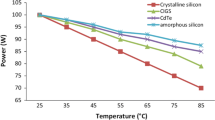Abstract
There will be serious thermal problems in the photovoltaic system of sunlight-concentrating space solar power station (SSPS), which will reduce the conversion efficiency of the photovoltaic system and overall energy transmission of the whole system. In this paper, based on the thermal problems in the optoelectronic system of SSPS via Orb-shape Membrane Energy Gathering Array (SSPS-OMEGA), a thermal management strategy of full-spectrum selective photonic thin-film based on the photoelectric characteristics of photovoltaic cells and pump-driven fluid flow loop is proposed with combination of passive and active cooling methods. Simulation results indicate that the full-spectrum selective thin film can significantly reduce the parasitic heat source in ultraviolet band and sub-band gap, from 205 to 72.8 W/m2 and from 46 to 4.5 W/m2, respectively. Meanwhile, it can effectively increase the emissivity from 0.84 to 0.938. On the other hand, the pump-driven fluid flow loop is designed and the temperature of the PV cell array is well controlled below 50 ℃ for ground-based demonstration validation system of the SSPS-OMEGA project. Finally, a simple experiment investigation is carried out demonstrate the thermal control performance of pump-driven fluid flow loop for photoelectric system.














Similar content being viewed by others
References
Glaser PE (1968) Power from the sun: its future. Science 162:857–861
Petroleum B (2015) Statistical review of world energy. British Petroleum, London
DOE/NASA (1980) Program Assessment Report Statement of Finding – Satellite Power Systems, Concept Development and Evaluation Program, DOE/ER-0085
Sasaki S, Tanaka K, Higuchi K, Okuizumi N, Kawasaki S et al (2006) A new concept of solar power satellite: tethered-SPS. Acta Astronaut 60:153–165
Seboldt W, Klimke M, Leipold M, Hanowski N (2001) European Sail tower SPS concept. Acta Astronaut 48:785–792
Hou XB, Wang L, Zhang XH, Zhou L (2015) Concept design on multi-rotary joints SPS. J Astronaut 36:1332–1338
Mankins J (2003) The promise and the challenge of space solar power. NASA Headquarters Adv. Syst. Briefing, p 13
Mankins JC (2014) The case for space solar power, 1st edn. Virginal Edition Publishing, Houston
Yang Y, Zhang YQ, Duan BY, Wang DX, Li X (2016) A novel design project for space solar power station. Acta Astronaut 121:51–58
Fan GH, Duan BY, Zhang YQ, Yang Y et al (2021) Secondary concentrator design of an updated space solar power satellite with a spherical concentrator. Sol Energy 214:400–408
Duan BY (2018) The main aspects of the theory and key technologies about Space Solar Power Satellite (in Chinese). Sci Sin Tech 48:1207–1218
Duan BY (2017) On new developments of Space Solar Power Station (SSPS) of China. In: The 36th international space development conference. St. Louis, USA, May 25–26
Curran D, Lam TT (1996) Weight optimization for honeycomb radiators with embedded heat pipes. J Spacecr Rock 33:822–828
Hung K, Deng Z (2010) Thermal design and optimization of heat pipe radiator for satellites. In: Computer-Aided Drafting, Design and Manufacturing (CADDM) Journal 20
Sam KFCH, Deng Z (2011) Optimization of a space based radiator. Appl Therm Eng 31:2312–2320
Spencer S, Bang N, Jaffe P (2012) Thermal analysis of space-based solar power system study photovoltaic DC to RF Antenna Module (PRAM). In: International energy conversion engineering conference
Jaffe P, Hodkin J, Harrington F et al (2014) Sandwich module prototype progress for space solar power. Acta Astronaut 94(2):662–671
Yang C, Hou XB, Wang L (2017) Thermal design, analysis and comparison on three concepts of space solar power satellite. Acta Astronaut 137:382–402
Ji XF, Zhang YQ, Li XL, Fan GH, Li M (2019) Solar ray collection rate fluctuation analysis with Monte Carlo Ray Tracing method for space solar power satellite. Sol Energy 185:235–244
Sato D, Yamada N, Tanaka K (2017) Thermal design of photovoltaic/microwave conversion hybrid panel for space solar power system. IEEE J Photovolt 7:374–382
Bergman TL, Lavine AS, Incropera FP, Dewitt DP (2011) Fundamentals of heat and mass transfer, 7th edn. Wiley, Amsterdam
Born M, Wolf E (2000) Principles of optics: electromagnetic theory of propagation, interference and diffraction of light, 6th edn. Cambridge University Press, Macmillan
Oh G, Kim Y, Lee SJ, Kim EK (2020) Broadband antireflective coatings for high efficiency InGaP/GaAs/ InGaAsP/InGaAs multi-junction solar cells. Sol Energy Mater Sol Cells 207:110359
Tao WQ (2001) Numerical Heat Transfer, 2nd edn. Jiaotong University Press, **’an
Acknowledgements
This work was supported by the National Natural Science Foundation of China (Nos. 52022075 and U1937202), Natural Science Basic Research Program of Shaanxi (No. 2021JCW-05), and the Fundamental Research Funds for the Central Universities (Nos. QTZX2188 and QTZX2173).
Author information
Authors and Affiliations
Corresponding author
Ethics declarations
Conflict of interest
On behalf of all authors, the corresponding author states that there is no conflict of interest.
Rights and permissions
About this article
Cite this article
Fan, G., Duan, B., Zhang, Y. et al. Thermal Management Strategy of Photoelectric System of Sunlight Concentrating Space Solar Power Station. Adv. Astronaut. Sci. Technol. 5, 19–29 (2022). https://doi.org/10.1007/s42423-022-00097-6
Received:
Revised:
Accepted:
Published:
Issue Date:
DOI: https://doi.org/10.1007/s42423-022-00097-6




